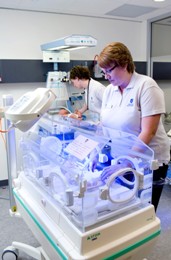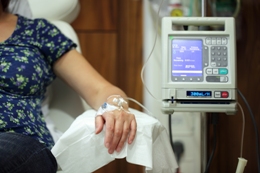04 December 2015
 Research into nursing including, midwifery, mental health nursing and patient care at UniSA has been recognised as well above world-class.
Research into nursing including, midwifery, mental health nursing and patient care at UniSA has been recognised as well above world-class.
The University received a level five rating for nursing in the 2015 Excellence in Research for Australia (ERA) evaluation, reflecting a commitment to informing best practice in teaching in one of the largest programs offered at the University, through a vibrant and engaged research culture.
Nursing is one of 16 discipline areas, including research into the causes and treatment of cancer, into physiotherapy, human movement and sports science, clinical sciences, pharmacology and pharmaceutical sciences and nutrition and dietetics, to receive well above world-class rating at UniSA.
In total, UniSA achieved the top “5” rating for research excellence that is “well above world standard” in 16 research fields, an eightfold improvement in 5 ratings since the last time evaluation was performed in 2012.
UniSA Deputy Vice Chancellor: Research, Professor Tanya Monro says the remarkable improvement is evidence that UniSA is attracting and nurturing outstanding researchers and research leaders in its areas of strength.
“When you are the state’s largest educator in a field as critical as nursing - which is evolving rapidly and is on the frontline of care for people from across the whole community - it is so important that there is a strong culture of discovery informing your teaching and that students learn from those who are at the forefront of knowledge in their field,” Prof Monro says.
“This excellent result reflects a huge increase in the amount and quality of research into nursing undertaken at UniSA and it is research we are conducting with valuable partners in government and private enterprise across all the whole discipline from aged care, right through to midwifery and specialist fields such as acute care and mental health nursing.
“We are committed to strengthening our research so that it is not only world-class, but is always focussed on supporting care sector innovations and on bringing real benefits to people.”
UniSA Vice Chancellor Professor David Lloyd says the results reaffirm the University’s commitment to undertaking research that is both high quality and relevant.
“We have taken on board the Government’s agenda and our community’s need to advance knowledge in key areas and these results show we are delivering in those areas,” Prof Lloyd says.
“Along with these excellent results in health research, UniSA has also earned the well above world-class rating for research that is supporting a cleaner more efficient mining and resources sector, rapid innovations in solar technology, huge advances in the development of new materials that support new green industries, and innovations and advances in bio-nanotechnology that are revolutionising our approaches to drug development, wound treatments, and biosecurity.
“We are building the expertise to make the kinds of contributions that transform society by supporting better outcomes for all Australians, the development of new industries, and a more prosperous nation.
“In Australia universities have a pivotal role in powering enterprise through the development of new knowledge and at UniSA we see this as central to our research culture.”
Media contact: Michèle Nardelli office +61 883020966 mob 0418823673 email michele.nardelli@unisa.edu.au
Research in Nursing - The six-minute ultrasound that saves lives
 It is not well known, but one of the leading causes of death for patients receiving chemotherapy is not the cancer itself, but the formation of dangerous blood clots.
It is not well known, but one of the leading causes of death for patients receiving chemotherapy is not the cancer itself, but the formation of dangerous blood clots.
Clots often form as a consequence of chemotherapy treatments that use straw-like catheters to deliver chemotherapy drugs into a patient’s veins. If the clots break away, they can cause strokes or other serious problems.
UniSA researcher, lecturer in nursing, and former clinical practitioner in thoracic medicine, Rebecca Sharp, has devised a simple new technique that reduces the development of clots and is saving patient lives.
“My research has shown that the simple act of finding a vein of the appropriate size before inserting the drug delivery device can make all the difference to patient safety,” Sharp says.
Using ultrasound to study vein size in patients receiving hospital treatment for cancer, Sharp found that to reduce the risk of clotting, the intravenous delivery device should occupy less than 45 per cent of the selected vein width.
Taking up more of the vein increases the risk of a blood clot by more than tenfold.
The new research belies traditional textbook advice that veins are all average size.
Sharp found that the vein typically thought of as being the biggest is only so in about half the people receiving treatment.
Following the research results, a new care protocol is being introduced that ensures all patients are assessed to find the right-sized vein before chemotherapy commences.




